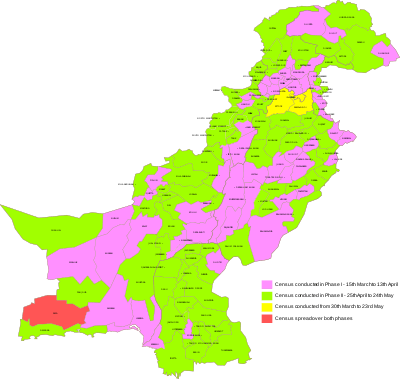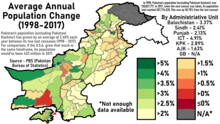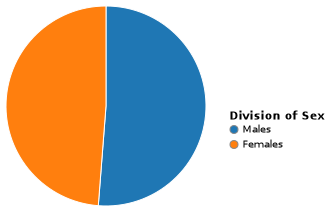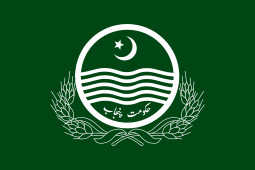2017 Census of Pakistan
The 2017 Census of Pakistan was a detailed enumeration of the Pakistani population which began on 15 March 2017 and ended on 25 May 2017. The census was conducted by the Pakistan Bureau of Statistics for the first time in 21st century, after 19 years.[1][2] Initial estimates would put the population at 20 crore (210–220 million).[3] The provisional results were finally presented to the Council of Common Interests on 25 August 2017, and then approved and released to the public. The results showed a total population of Pakistan at 207,774,520 people.[4][5][6][7] As of December 2019, the complete and final results of the census had still not been published.[8]
The 2018 Pakistani general election was held under a new delimitation of constituencies, based on the provisional results of the 2017 census.[9]
| Sixth Census of Pakistan | |
|---|---|
 | |
| General information | |
| Country | |
| Date taken | 15 March 2017 to 25 May 2017 |
| Total population | 207,774,520 |
| Percent change | |
| Annual percent change | 2.4% |
| Most populous province/territory | Punjab |
| Least populous province/territory | Capital Territory |
Details
The census was conducted by 91,000 enumerators from various government sectors, of which the Pakistan Army provided security with 200,000 personnel.[10] The census recorded a total of 9 languages out of an estimated of 80 languages spoken in the country,[11] and officially recognized transgender as a third gender.[12]
Phases
The census was conducted in 2 phases. The first phase lasted from 15 March 2017 to 13 April 2017 and covered 63 districts of the country. The second phase began on 25 April 2017 and lasted until 24 May 2017 covering the remaining 88 districts. However, the census in the Islamabad Capital Territory and neighbouring districts of Attock and Rawalpindi, although included in the second phase, began on 30 March 2017 and concluded on 23 May 2017. Furthermore, for administrative purposes, the census in the Kech District of Balochistan was spread over both phases.[13]

Results

The provisional results of the 2017 Census were presented to the Council of Common Interests on 25 August 2017.[14] According to the results, the total population in Pakistan was 207,774,520, representing a 57% increase in 19 years.[15][16] The provisional results exclude data from Gilgit-Baltistan and Jammu & Kashmir, which is likely to be included in the final report in 2018.[17][18][19][20] The urban population in Pakistan stood at 75,580,000 or 36.4% of the total population.[21]
| Administrative Unit | Households | Total Population (1998) | Total Population (2017) | Annualized Growth | Share in Total Population |
|---|---|---|---|---|---|
| Khyber Pakthunkhwa | 3,845,168 | 17,743,645 | 30,523,371 | 2.89% | |
| Tribal Areas | 558,379 | 3,176,331 | 5,001,676 | 2.41% | |
| Sindh | 8,585,610 | 30,439,893 | 47,886,051 | 2.41% | |
| Punjab | 17,103,835 | 73,621,290 | 110,012,442 | 2.13% | |
| Balochistan | 1,775,937 | 6,565,885 | 12,344,408 | 3.37% | |
| Islamabad Capital Territory | 336,182 | 805,236 | 2,006,572 | 4.91% | |
| PAKISTAN | 32,205,111 | 132,352,279 | 207,774,520 | 2.40% | 100% |
| Gilgit-Baltistan | TBA | 870,347 | TBA | TBA | TBA |
| Azad Jammu and Kashmir | TBA | 2,972,523 | 4,045,366 | TBA | TBA |
| PAKISTAN (incl: AJK, GB) | TBA | 136,195,149 | TBA | TBA | N/A |
| Population | Total | 207,774,520 |
| Males | 106,443,520 | |
| Females | 101,331,000 |

City
The population of 10 major cities of the country has increased by 74.4 percent since 1998, when the last census was conducted, according to the data of recently concluded 6th Population and Housing Census 2017.
The total population of the 10 cities surged to 40,956,232 individuals as per the 2017 census from 23,475,067 registered during the 1998 census, the data revealed.[22][23][24]
| Rank | City | Population (1998 census) | Population (2017 census) | Change of Growth | Province |
|---|---|---|---|---|---|
| 1 | Karachi | 9,339,023 | 14,910,352 | 37.37% | Sindh |
| 2 | Lahore | 5,143,495 | 11,126,285 | 53.77% | Punjab |
| 3 | Faisalabad | 2,008,861 | 3,203,846 | 37.30% | Punjab |
| 4 | Rawalpindi | 1,409,768 | 2,098,231 | 32.81% | Punjab |
| 5 | Gujranwala | 1,132,509 | 2,027,001 | 44.13% | Punjab |
| 6 | Peshawar | 982,816 | 1,970,042 | 50.11% | Khyber-Pakhtunkhwa |
| 7 | Multan | 1,197,384 | 1,871,843 | 36.03% | Punjab |
| 8 | Hyderabad | 1,166,894 | 1,732,693 | 32.65% | Sindh |
| 9 | Islamabad | 529,180 | 1,014,825 | 47.86% | Islamabad Capital Territory |
| 10 | Quetta | 565,137 | 1,001,205 | 43.55% | Balochistan |
Controversies
Religion Census
The Religion census data was due to be released in March 2018 but it has still not been made public. Mangla Sharma, provincial lawmaker from Muttahida Qaumi Movement-Pakistan (MQM-P) said “The government must end its discriminatory policies and focus on releasing the results,”.[25][26]
Transgender population
Transgender rights campaigners have claimed the count of 10,418 transgender people nationally in the 2017 census significantly underestimates the size of Pakistan's transgender population. Mona Ali, who is a leader of a Lahore-based transgender rights group known as the Khawaja Sira Society, estimates there are 400,000 to 500,000 transgender people in the Punjab province alone. Bindya Rana, leader of the Karachi-based transgender rights group Jiya, estimates that there are 300,000 transgender people across Pakistan. The census identified transgender people according to their national identity cards, not accounting for those whose cards do not disclose their transgender status in order to avoid discrimination.[27]
Sindh population
The Sindh Assembly refused to accept the results of the 2017 census, stating that millions of people were shown with double addresses and counted in their home provinces despite living and working in Sindh.[28] In April 2018, Mustafa Kamal, chairman of the Pak Sarzameen Party and former Mayor of Karachi, challenged the results of the 2017 census in the Supreme Court, seeking a third-party audit of the national census. Kamal pleaded that records from the National Database and Registration Authority (NADRA) showed the population of Karachi to be 20.15 million, rather than 16 million as shown in the census.[29]
FATA population
Shahab Uddin Khan, a Member of the National Assembly (MNA) from Bajaur Agency, has stated he believes that a large number of people displaced from the Mamund and Nawagai regions due to security operations have not been counted by the census. He has stated he intends to challenge the census in court. Bismillah Khan, an MNA from Bajaur Agency, has stated he believes the population of the Federally Administered Tribal Areas is double of what is reflected in the census. He added that he will take up the issue with the federal government along with other lawmakers. Sajid Hussain Turi, an MNA from Khyber Agency, claimed that more than three million people from FATA are living in other cities in the country due to military operations, and expressed concern that developmental work in the region could be underfunded if the population is underestimated by the census.[30]
Political opposition
Syed Khurshid Ahmed Shah of the Pakistan Peoples Party (PPP), Former Leader of the Opposition in the National Assembly, questioned the provisional census results. He issued a statement demanding that data collected by the statistics division should be compared to data from the Pakistan Army. PPP leader Nawab Muhammad Yousuf accused authorities of doctoring the results, alleging that the population of Sindh had been intentionally underestimated by at least 10 million and the population of Punjab had been overestimated by 10 million. He described the results as an attempt to usurp the rights of Sindh. PPP Senator Mukhtiar Ahmed Dhamrah disputed the population of Karachi and Lahore reported in the preliminary results.[31]
Bushra Gohar, leader of Awami National Party (ANP), pointed out in a tweet that the reported population of around 5 million for the Federally Administered Tribal Areas seems contradictory to the fact that there have been nearly 2 million internally displaced persons registered from North Waziristan alone.[31]
Chief Census Commissioner Asif Bajwa rejected allegations that the census results had been manipulated and that the population of Karachi had been intentionally understated. He stated that the populations of Karachi and Lahore were counted as per the record of national identity cards and voter lists and that the census data had already been verified with statistics recorded by the army.[32]
Security incidents






References
- "Why the census is important for Pakistan".
- "In pictures: Census teams go door-to-door for Pakistan's first nationwide headcount in 19 years". DAWN.COM. 15 March 2017. Retrieved 21 March 2017.
- "Initial estimates after Census 2017 put population at 21–22 crores – Pakistan – Dunya News". dunyanews.tv. Retrieved 26 July 2017.
- http://www.pbs.gov.pk/content/population-census Pakistan Bureau of Statistics
- http://www.pbs.gov.pk/content/provisional-summary-results-6th-population-and-housing-census-2017-0 Results
- "Pakistan, Let's Talk About Sex".
- "6th census findings: 207 million and counting – The Express Tribune". 25 August 2017. Retrieved 25 March 2018.
- The data on e.g. minorities had still not been published, and on 13 december 2019, the Human Rights Commission of Pakistan and the National Interfaith Working Group informed that they should be released as soon as possible."Equal rights as citizens, not just as minorities".
- "How constituency boundaries were redrawn across Pakistan".
- "Population census 2017: Why this extensive exercise will be defective". DAWN.COM. 13 February 2017. Retrieved 14 March 2017.
- "Pakistan's 6th census: A third sex, nine languages, many faiths". DAWN.COM. 13 March 2017. Retrieved 14 March 2017.
- "Transgender population to be counted in population census for first time". DAWN.COM. 9 January 2017. Retrieved 14 March 2017.
- "Distribution of Districts in Phases". Pakistan Bureau of Statistics. Retrieved 26 March 2017.
- "Enumerating Pakistan".
- "132 million in 1998, Pakistan's population now reaches 207.7 million: census report". ARYNEWS. Retrieved 25 August 2017.
- http://ww2.pbscensus.gov.pk/content/press-release-provisional-summary-results-6th-population-and-housing-census-2017-0%5B%5D
- "Pakistan's population reaches 208 million: provisional census results".
- "Pakistan's 6 th Census – 207 Million People Still Stuck In Malthusian Growth".
- "Pakistan's population surges to 207.8 million".
- "Pakistan's population has ballooned to 207.8m, provisional census results show".
- "6th census findings: 207 million and counting".
- "Ten major cities' population up by 74pc". Retrieved 6 September 2017.
- "Daily Mashriq". Daily Mashriq (in Urdu). Archived from the original on 22 September 2018. Retrieved 6 September 2017.
- "District Wise Census Results Census 2017" (PDF). Archived from the original (PDF) on 29 August 2017.
- "Census 2017: Two years on, govt mum on official minority count". 26 August 2019. Retrieved 30 March 2020.
- "Two years after it counted population, Pakistan silent on minority numbers". 7 January 2020. Retrieved 30 March 2020.
- Ebrahim, Zofeen T. (7 October 2017). "Don't we count? Transgender Pakistanis feel sidelined by census". Thomson Reuters. Thomson Reuters Foundation. Retrieved 2 May 2018.
- Ghori, Habib Khan (3 November 2017). "Sindh Assembly refuses to accept census results". Dawn. Karachi, Pakistan: Pakistan Herald Publications. Retrieved 11 May 2018.
- "Mustafa Kamal challenges census 2017 results in SC". Daily Pakistan. 25 April 2018. Retrieved 11 May 2018.
- Ullah, Izhar (26 August 2017). "Census 2017: FATA lawmakers dispute census count". The Express Tribune. Karachi, Pakistan. Retrieved 11 May 2018.
- Khan, Iftikhar A. (27 August 2017). "Opposition parties suspicious of census results". Dawn. Karachi, Pakistan: Pakistan Herald Publications. Retrieved 13 May 2018.
- Guramani, Nadir (10 November 2017). "Census commissioner rejects political parties' concerns". Dawn. Karachi, Pakistan: Pakistan Herald Publications. Retrieved 13 May 2018.
- "Census team attacked in Nowshera". Dawn.com. Retrieved 9 May 2017.
- "Census team attacked in Charsadda, policeman injured". Dawn.com.
- "5 armed forces personnel slain in Lahore blast targeting census team". Dawn. Retrieved 5 April 2017.
- Baloch, Behram. "Security man tasked to guard census team loses life in attack". Dawn.com.
- Firdous, Iftikhar. "14 killed as passenger van hits landmine in Kurram Agency". The Express Tribune.
- Shahid, Saleem. "12 dead, 40 hurt in Afghan attack during census". Dawn.com. Retrieved 9 May 2017.
- "Clash erupts on Afghan-Pakistan border". BBC News. 5 May 2017. Retrieved 5 May 2017.